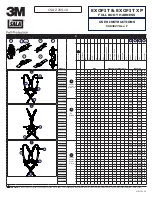
App-9
IM DL850E-01EN
Cross Spectrum
The cross spectrum is determined from two signals. It is the product of the linear spectrum of one signal (Gy)
and the complex conjugate (Gx
*
) of the linear spectrum of the other signal (Gx).
If the linear spectrums of the two signals are represented by
Gx = Rx + jIx
Gy = Ry + jIy
then the cross spectrum Gyx is
Gyx = Gy × Gx
*
= (Ry + jIy)(Rx − jIx) = Ryx + jIyx
where Ryx = RyRx + IyIx
Iyx = RxIy − RyIx
The DL850E/DL850EV can determine the following spectrums.
Item
Expression
Computation
Real part
CS-REAL
Ryx/2
Imaginary part
CS-IMAG
Iyx/2
Magnitude
CS-MAG
(Ryx
2
+Iyx
2
)/2
Log magnitude CS-LOGMAG
10 × log (
(Ryx
2
+Iyx
2
)/2
)
Phase
CS-PHASE
tan
−1
(Iyx/Ryx)
Transfer Function
The transfer function expresses the frequency responses of the input to and the output from the transfer system.
The transfer function is determined by the ratio of the output linear spectrum (Gy) and the input spectrum (Gx)
at each frequency. Also, as can be seen from the following equation, the transfer function can be defined as the
ratio of the cross spectrum of the input and output (Gyx) and the input power spectrum (Gxx).
Transfer function = Gy/Gx = (Gy × Gx
*
)/(Gx × Gx
*
) = Gyx/Gxx
= (Ryx + jIyx)/(Rx2 + Ix2)
The DL850E/DL850EV can determine the following items.
Item
Expression
Computation
Real part
TF-REAL
Ryx/(Rx
2
+ Ix
2
)
Imaginary part
TF-IMAG
Iyx/(Rx
2
+ Ix
2
)
Magnitude
TF-MAG
(Ryx
2
+Iyx
2
)
/(Rx
2
+ Ix
2
)
Log magnitude TF-LOGMAG
20 × log
(Ryx
2
+Iyx
2
)
/(Rx
2
+ Ix
2
)
Phase
TF-PHASE
tan
−1
(Iyx/Ryx)
The magnitude of the transfer function shows the ratio of the magnitudes of the output linear spectrum and the
input linear spectrum while the phase shows the phase difference of the two.
Coherence Function
The coherence function expresses the ratio of the output power generated by the input signal to the transfer
system and the total output power.
Coherence function = Gyx × Gyx
*
/(Gxx × Gyy)
Item
Expression
Computation
Phase
CH-MAG
(Ryx
2
+ Iyx
2
)/(Gxx × Gyy)
If the output signal is due entirely to the input signal, the coherence function becomes 1. As the ratio decreases,
it falls below 1. Thus, the coherence function always takes on a value between 0 and 1.
On one data acquisition, the coherence function becomes 1 across all frequencies. Make sure to take the
frequency average of the computation.
Appendix
















































